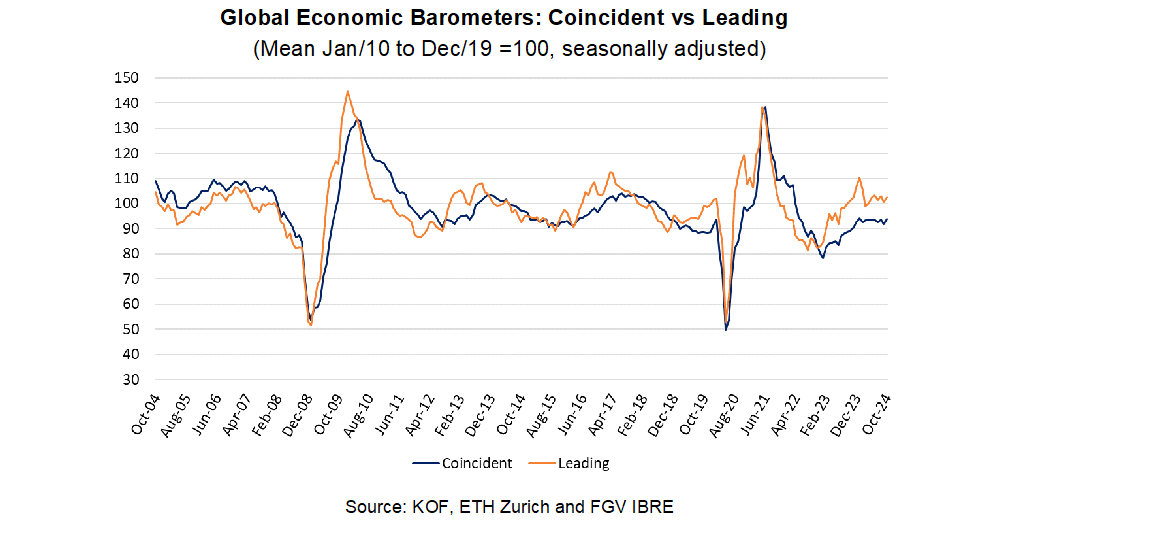Global Barometers signal continued moderate growth of the world economy
The Global Barometers record a small increase in October, largely offsetting the previous month’s decline. The Coincident Barometer continues to signal economic development below the medium-term average, while the leading barometer continues to point to a normalisation of growth in the coming months.
The Coincident Global Economic Barometer increases by 2.1 points in October, to reach 93.8 points, while the Leading Barometer gains 1.9 points, to 102.5 points. The rise in both indicators is mainly driven by the results of the Asia, Pacific & Africa region.
“Since December 2022, the leading global barometer has been more positive or less negative than the coincident global barometer. For some time now, both indicators have been moving more or less sideways. This is historically quite unique and suggests that general expectations of economic normalisation seem to be repeatedly disappointed. At present, the situation in the Middle East seems to be preventing a real recovery in the global economy. We remain hopeful that solutions will be found that will allow us to move forward and that the assessment of the situation will improve significantly in the near future”, evaluates Jan-Egbert Sturm, Director of KOF Swiss Economic Institute.

“At present, the situation in the Middle East seems to be preventing a real recovery in the global economy. We remain hopeful that solutions will be found that will allow us to move forward.”Jan-Egbert Sturm, Director of KOF Swiss Economic Institute
Coincident Barometer – regions and sectors
The gain in the Coincident Barometer in October is the result of a 2.2-point positive contribution of the coincident indicator for the Asia, Pacific & Africa region, while Europe remains stable, and the Western Hemisphere contributes slightly negatively with -0.1 points. After losing ground between February and July of this year, the indicator for the Asia, Pacific & Africa region has stopped falling, and now fluctuates between 88 and 92 points, signalling the difficulty of the region to regain the increasing tendency observed in 2023.
All the Coincident sector indicators increase in October, with Construction standing out. Economy (aggregated business and consumer evaluations) remains at the lowest level among the sector indicators.
Leading Barometer – regions and sectors
The Leading Global Barometer leads the world economic growth rate cycle by three to six months on average. In October, the Asia, Pacific & Africa region and the Western Hemisphere contribute positively to the aggregate result with 1.7 and 0.4 points, respectively, while Europe contributes in the opposite direction with -0.2 points.
In October, all the Leading sector indicators increase, with Construction standing out for a gain of over 10 points, reaching a level that reflects a positive outlook.
The Global Economic Barometers
The Global Economic Barometers are a system of indicators enabling timely analysis of global economic development. They represent a collaboration between the KOF Swiss Economic Institute of the ETH Zurich in Switzerland and Fundação Getulio Vargas (FGV), based in Rio de Janeiro, Brazil. The system consists of two composite indicators, the Coincident Barometer and the Leading Barometer. The Coincident Barometer reflects the current state of economic activity, while the Leading Barometer provides a cyclical signal roughly six months ahead of current economic developments.
The two Barometers comprise the results of economic tendency surveys conducted in more than 50 countries with the aim of achieving the broadest possible global coverage. The advantages of economic tendency surveys are that their results are usually readily available and are not substantially revised after first publication.
The Coincident Barometer includes more than 1,000 different time series, while the Leading Barometer consists of over 600 time series. Cross-correlation analysis is used to decide which individual time series are included in the barometers. This involves correlating the individual time series with a reference series. The reference series used is the year-on-year growth rate of global gross domestic product (GDP), where the individual national GDPs are aggregated at purchasing power parity to form global GDP. A time series is only included in a Barometer if it shows a sufficiently high correlation and a suitable synchronization or lead with the reference series. The time period used for this correlation analysis currently runs from January 2010 to December 2019.
The series of the two Barometers are revised each month at publication and are standardized to have a mean of 100 and a standard deviation of 10 for the 10-year period previous to the most recent observations.
The methodology is described in:
Klaus Abberger, Michael Graff, Aloisio Jr. Campelo, Anna Carolina Lemos Gouveia, Oliver Müller and Jan-Egbert Sturm (2020), The Global Economic Barometers: Composite indicators for the world economy. KOF Working Papers, vol. 471, Zurich: KOF Swiss Economic Institute, ETH Zurich, 2020.
Contact
KOF Konjunkturforschungsstelle
Leonhardstrasse 21
8092
Zürich
Switzerland

